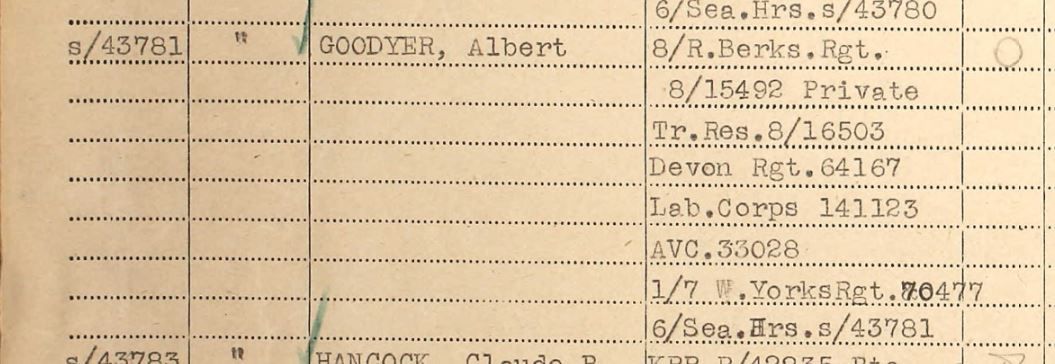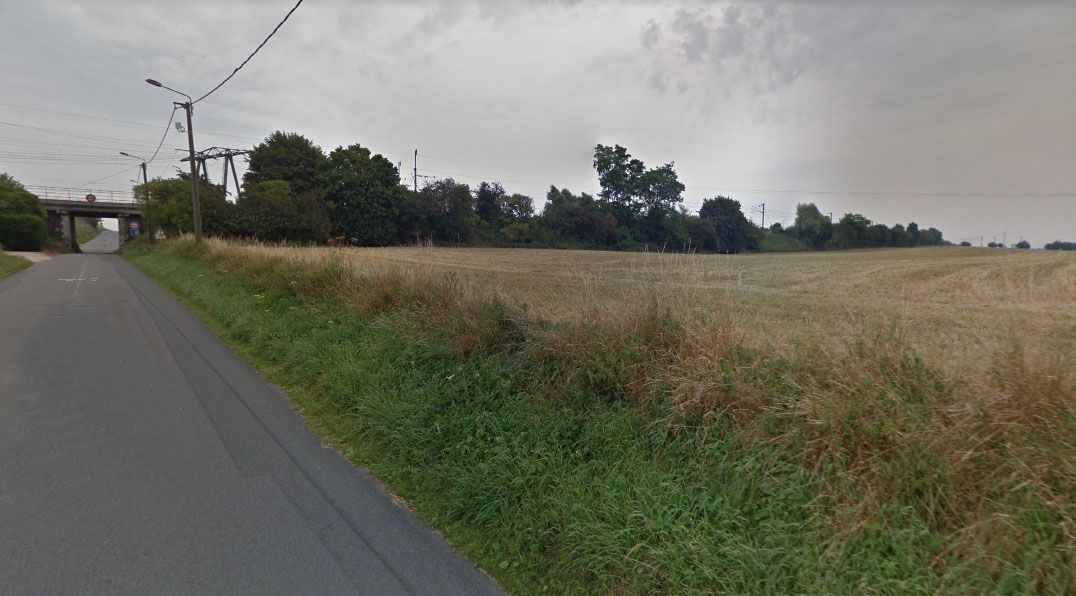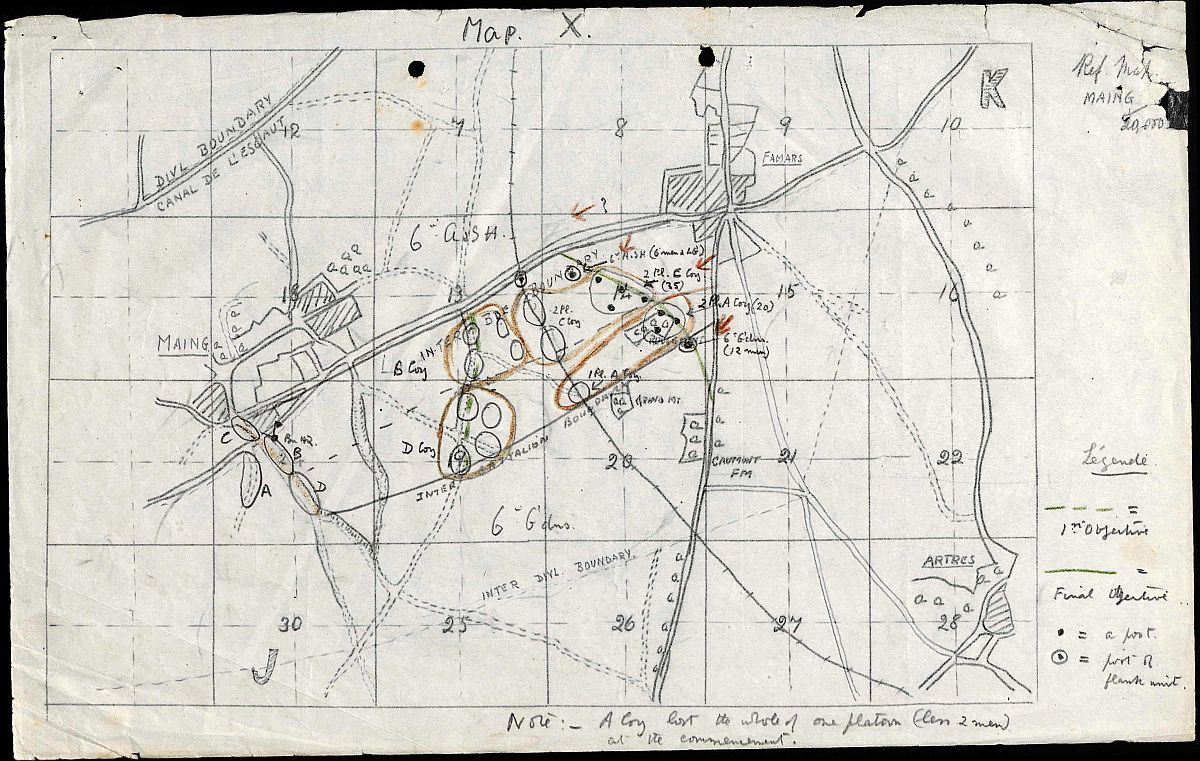Albert Goodyear
Private S/43781 Albert Goodyear, 1st/6th Battalion, Seaforth Highlanders.
Bertie was born in 1893 in St Mary Bourne, Hampshire, the eldest child of Lovelace George Goodyear and his wife Julia Alice née Bartholomew. In the years to follow the family grew while moving gradually towards Newbury. William George was born in St Mary Bourne in 1895, Frederick Charles in Crux Easton in 1898, Ernest Walter in Ashmansworth in 1901, and, finally, Florence May in Newbury in 1909. Sadly Frederick did not make the move to Newbury as he died, aged only 2, in 1901.
Lovelace was a farm worker and was working as a carter by the time he reached Newbury where the family lived at Berkeley Cottages in what was then Speenhamland Backway but is now a part of Pelican Lane. Given this location his most likely employer was Thomas Kimber at Speenhamland Farm at the end of the Backway. They lived first in no 4 Berkeley Cottages (from 1906 to 1913) and later at no 1 until it was renamed as 28 Pelican Lane. Julia died in 1933 following which Lovelace moved to live with Ernest and his family in West Drayton, where he died in 1937.
Bertie’s schooling would have been finished by the time he came to Newbury, presumably he was educated at the village school at Ashmansworth. In Newbury he worked as a labourer though he was out of work at the time of the 1911 census.
He enlisted into the army in or around November 1914 and his name soon appeared in the Active Service Roll printed in the Newbury Weekly News as Private Goodyear A, Royal Berkshire Regiment. This was, of course a very typical entry for local lads since so many of them enlisted into the local regiment. However, Bertie’s career was far from typical.
After the war every regiment produced medal rolls – ledgers full of the details of men who served in the regiment and were eligible for the campaign medals. Separate rolls were prepared for the 1914 Star, the 1914-15 Star and (together) the British War Medal and Victory Medal. The 1914-15 Star roll for the Seaforth Highlanders lists Bertie (as Albert) and notes that he qualified for this medal because he entered a theatre of war on 7 August 1915 and that he did so while serving with the Royal Berkshire Regiment. This was the date that his battalion, the 8th Royal Berks, crossed the Channel to Le Havre.

Bertie's entry in the British War and Victory Medals Roll. |
His entry for the British War and Victory Medals is eye-opening – obviously there was going to be mention of the Royal Berks and Seaforth Highlanders, but his army career was far more wide ranging that a mere two infantry regiments. He was in the 8th Battalion, Royal Berkshire Regiment (No 8/15492), the Training Reserve (8/16503), the Devonshire Regiment (64167), the Labour Corps (141123) the Army Veterinary Corps (33028), the 1/7th Battalion, West Yorkshire Regiment (70477) and, finally, the 6th Battalion, Seaforth Highlanders (S/43781). The medal rolls only record units in whch a man served in a theatre of war - so, by implication, Bertie served in all of these units somewhere in France and Flanders.
This order is as listed in the medal roll, it is probable that it reflects his journey through the British Army, but the one surviving page of his service record is an undated army form B278 – List of Transfer Documents. This only contains the Training Reserve and Army Veterinary Corps – no sign of the Devonshire Regiment or Labour Corps. This casts some doubt on the order, but taken on its own this single form cannot be taken as anything more than supporting evidence for two of the postings between his departure from the Royal Berks and arrival at the Seaforth Highlanders.
Moves from battalion to battalion, regiment to regiment, were usually prompted by a break in service as the result of sickness or wounding. In Bertie’s case he was reported as wounded in an official casualty list on 22 October 1915, six weeks after he arrived in France. A name would typically appear on a casualty list several weeks after the event, he almost certainly one of the many men wounded in the battalion’s baptism of fire at Hulloch in the Battle of Loos, 25 September 1915.
Without access to his service record it is impossible to tell when or for how long he served with each unit, all that can be certain is that he was with the 6th Battalion, Seaforth Highlanders on 25 October 1918 when it took part in an advance on the village of Famars a short distance south-west of Valenciennes.
This was late in the war, during the period known as the 100 Days or the Advance to Victory; the formidable German defences of the Hindenburg Line were behind them, warfare had changed dramatically from the days in the trenches. The British were advancing towards Germany, every day saw the Germans pushed back somewhere along what had become a far less defined front. The Germans still fought hard and made up for falling numbers of troops with more machine guns – despite the inevitability of an Allied victory (which was obvious to all but the most optimistic Germans) British losses were high. This was partly due to the constant attacks but also to the loss of the protection offered by the trenches and dugouts of the old front line.
As the 6th Seaforths set out from their assembly positions along a sunken road in the village of Maing all apart from two men of one platoon from A Company were lost. A Company was not leading the attack, it was behind B and D Companies. Its losses were almost certainly due to artillery fire – which could as easily been British as German. Another factor of the more open warfare and repeated attacks was that the British artillery had less time to register their guns, and, as they were in action almost continuously, they were often using worn out barrels – both factors leading to less accuracy and an increased risk to their own troops whenever they attempted to lay down a barrage to cover an infantry advance.

The view up the Maing/Famars road showing what a formidable obstacle the railway embankment was at this point. |
Perhaps Bertie was one of the victims at the opening of the day, perhaps he lasted a little longer as B and D Companies took the first target and A and C Companies leapfrogged them to take the final target, a sunken road just short of Famars. Perhaps he fell victim to the German counter-attack that pushed A and C Companies back to the railway line that ran between the two target lines, where B and D Companies had established a makeshift defensive line. What is sure is that he died that day, just under three weeks from the end of the fighting.
His parents announced his death through a notice in the local paper:
Newbury Weekly News, 14 November 1918 – Killed in Action
GOODYEAR – On October 18 [sic], near Valenciennes, Pte A Goodyear, 1st Seaforth Highlanders, son of Mr and Mrs Goodyear, 1, Berkeley Cottages, Speenhamland, Newbury.
The date in this announcement is a week out, by the time the news was repeated in the local war news column of the same edition of the paper it had been corrected:
Newbury Weekly News, 14 November 1918 – Local War Notes
Mrs. Goodyear of 1, Berkeley Cottages, Speenhamland, has received the sad news that her son, Pte A Goodyear, of the Seaforth Highlanders, was killed on October 25th , south of Valenciennes. He was hit in the advance. The chaplain of the Battalion writes that he was buried in the British cemetery at Maing.
He was buried in the Maing Communal Cemetery Extension , grave A.26, alongside 29 of his comrades who also died that fateful day.
[pic Sunken road & cemetery]
He was not forgotten by his family:
Newbury Weekly News, 30 October 1919 – In Memoriam
GOODYEAR – In loving memory of our dear son, Pte A Goodyear, 1st Seaforth Highlanders, killed in action south-west of Valeciennes, Oct 25th, 1918, aged 26 years.
Sleep on, dear Albert, in your lonely grave,
A grave we shall never see;
But as life and memory lasts,
We shall remember thee.
His cheery ways, his smiling face,
Are pleasant to recall;
He had a kindly word for each,
He was beloved by all.
From his ever loving mother and dad, brothers and sister.

Bertie's name on Newbury War Memorial (centre) |
Locally he was remembered on tablet 8 of the Newbury Town War Memorial and the Speenhamand Shrine (his local parish memorial).
He may also be on the memorial erected in the Congregational Church, which includes Alfred Goodyear. The Commonwealth War Graves Commission has no record of any Alfred Goodyear dying in the war and there is only one Alfred Goodyear whose death is recorded in the right time period (1914-192) – a 38 year old who died in Croydon in 1918. Odds are that Alfred is an error and the name should be Albert Goodyear.
Thanks to Karen Newbery for her assistance researching this casualty.

Find a memorial :
| Died this day: | |
| 14 January 1944 | |
| R G Layley | |
| Newbury |

Like this site? Show your appreciation through a donation to a great charity.
